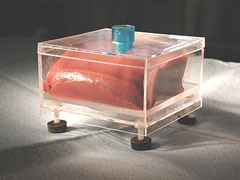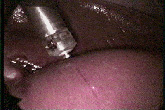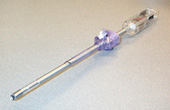 |

 |
|
 |
To support our efforts in physics-based surgical simulation, we require data on the mechanical properties of soft tissues, specifically the stress-strain/strain rate relationships over ranges relevant to the types of deformations that would be generated during typical surgical interventions. In addition, knowledge of tissue properties may be useful for diagnostic and surgical guidance purposes (i.e. real-time differentiation between healthy and compromised tissues). Further, highly accurate simulations could aid in surgical procedure development (minimizing the use of animal models), as well as surgical instrument prototyping (where CAD models of instruments could be tested on simulated anatomy). Our approach to biomechanical property data measurement involves applying mechanical deformations to tissues and observing the force and displacement responses.
The first Simulation Group-funded instrument developed for this purpose is the TeMPeST 1-D (Tissue Measurement Property Sampling Tools), a minimally invasive instrument for performing small-indentation testing on solid abdominal organ (i.e. liver, spleen, kidney) tissues, as well as other suitable structures. It is a prototype which will lead to the development of new instrumentation that will be suitable for use in measuring human organ properties. In preparation for such testing, it has been used both in laparoscopic and open surgical testing of porcine liver and spleen (porcine subjects often being used as surrogates for training on human patients). In addition, since the system is easily portable, it has been used to test other tissues including rodent (rat) organs in support of the NASA-Ames BioVis Technology Center virtual rat project, and make measurements of bovine, ovine and human vocal tissue samples with the Vocal Disorders Center the Massachusetts Eye and Ear Infirmary.
Our principle collaborator is the Harvard Biorobotics Laboratory with whom we are developing instrumentation for measuring properties of solid organ parenchymal and vascular tissues, as well as techniques for validating mathematical models of tissue deformation.
We are also working with the MIT Laboratory for Human and Machine Haptics , supporting the use of instrumentation developed to measure not just solid organs, but also esophageal properties, as well as the development of a simulation of a laparoscopic Heller myotomy procedure.
International collaboration has taken the form of work with the Minimally Invasive Surgery Section at the University of Tuebingen (Germany), with whom we performed direct comparisons between measurements made with our indentation technology, and their intrumentation (ROSA-2), which examines the response of tissue to torsional shearing (i.e. thetorque/angular displacement response).

Copyright
© CIMIT 2002. All rights reserved


